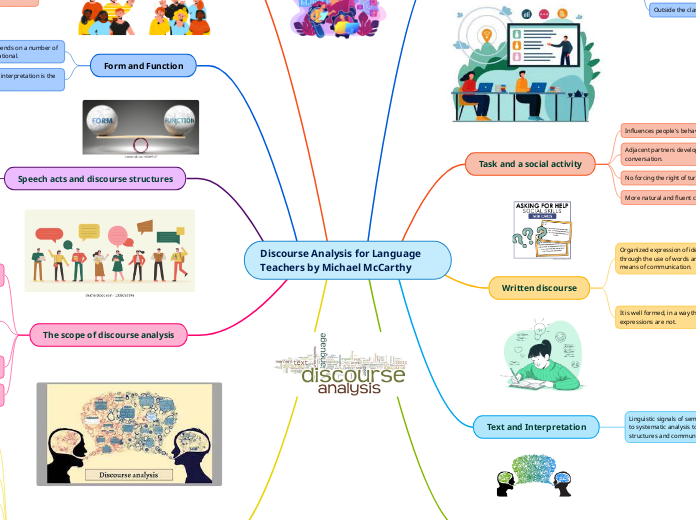Discourse Analysis for Language Teachers by Michael McCarthy
Conversations outside the classroom
Inside the classroom
They are structured (easy to perceive).
Defined questions and answers (predictable).
Outside the classroom
Vary according to the degree of structuring.
They differ according to the acts in which the conversation takes place.
According to complexity (simple or elaborated dialogues)
.
There are start-response-follow-up sequences.
Depends on conversational features (gestures, intonation, etc.)
Use of descriptive categories.
Hierarchical model (from small units to larger units).
Task and a social activity
Influences people's behavior.
Adjacent partners develop their characteristics in the conversation.
No forcing the right of turn in conversation.
More natural and fluent conversations.
Written discourse
Organized expression of ideas, thoughts or information through the use of words and text, writing is used as the main means of communication.
It is well formed, in a way that natural, spontaneous speech expressions are not.
Show sentence-to-sentence links in terms of grammatical features.
Grammatical cohesion can be enumerated finitely.
Compares between languages for translatability and distribution in real texts.
Text and Interpretation
Linguistic signals of semantic and discursive functions subject to systematic analysis to reveal underlying meanings, structures and communication strategies.
TEXT linguistic unit, spoken or written, subject to systematic analysis to reveal meanings, structures.
INTERPRETATION set of procedures and approach to text analysis that emphasizes the mental activities involved in interpretation can be widely understood.
Textual pattern recognition: phrases, clauses, sentences or groups of sentences.
Interaction between reader and text.
Relate textual segments to each other through relationships such as phenomenon-reason, cause-consequence.
Larger patterns in text
Clause-relational approach to text deals with broader patterns that occur regularly in text:
Problem-situation-response-evaluation.
They are often marked by the same type of grammatical and lexical devices, such as subordination and parallelism.
They are often marked by the same type of grammatical and lexical resources, such as subordination and parallelism.
They are objects of interpretation by the reading author.
A brief historical overview
Discourse analysis is concerned with the study of the relationship between language and the contexts in which it is used.
It grew out of work in different disciplines ( linguistics, semiotics, psychology, anthropology and sociology).
Discourse analysis has grown into a wide-ranging and heterogeneous discipline which finds its unity in the description of language.
Is not entirely separate from the study of grammar and phonology.
Labov's investigations of oral storytelling have also contributed to a long history of interest in narrative discourse.
Form and Function
How we interpret grammatical forms depends on a number of factors, some linguistic, some purely situational.
One linguistic feature that may affect our interpretation is the intonation.
Speech acts and discourse structures
Discourse analysis is thus fundamentally concerned with the relationship between language and the contexts of its use.
Discourses have beginnings, middles and ends.
The dialogue is structured in the sense that it can be coherently interpreted and seems to be progressing somewhere.
The scope of discourse analysis
It is not only concerned with description and analysis spoken interaction.
Verbal meetings, daily readings:
Articles
Letters
Stories
Instructions
Notices
Billboards
Comics
Recipes
Discourse analysis is interested in the organization of written interaction as well.
The objective is to indicate what the speech looks like speaking naturally.
Spoken discourse: models of analysis
The Birmingham model is a powerful approach to analyzing discourse
Structured lesson with framing moves, common in various settings.
Limited words
Question-answer sequence:
Internal trait or labelable forms of speech?
The particular exchange it consists of a question, an answer and a comment, making it a three-part questionnaire.
As a command
What time is it?
Heard as giving information
Conventions can vary culturally and depending on context.
We observe the importance of each step in the overall functional unit.
What is discourse analysis?
Study of language use, context, and social communication patterns.












